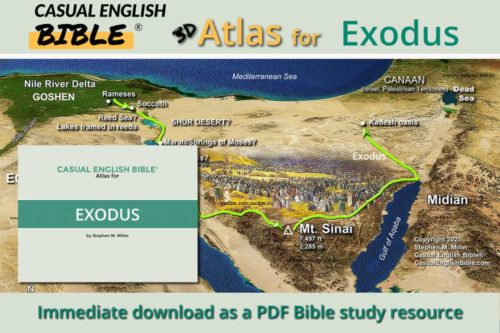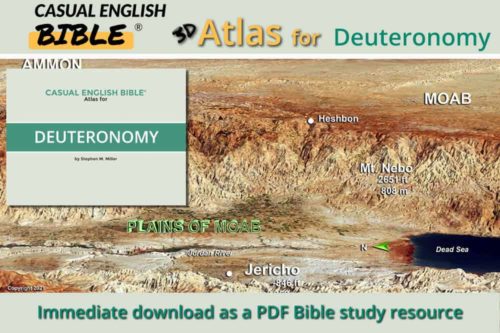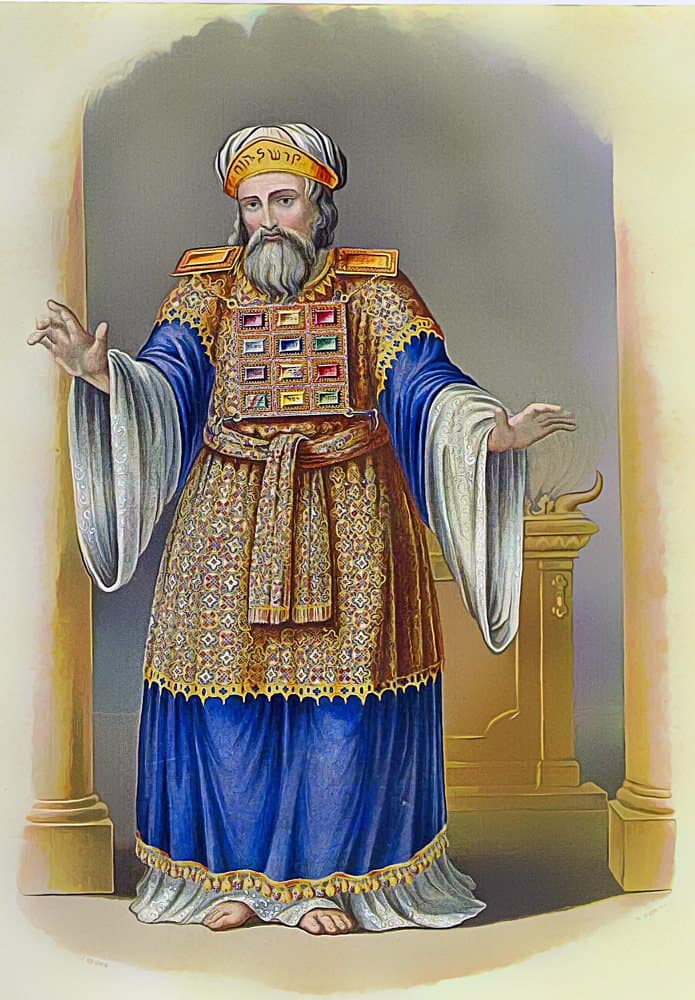Exodus 39
Israel finishes tent worship center
Making the priests clothes
1Artisans skilled in fabric made beautifully tailored clothes for priests who ministered in the tent worship center’s main room: the Sacred Room. Fabric colors were blue, purple, and crimson. Artisans also made Aaron’s high priestly clothes, as Moses instructed.2Bezalel made Aaron’s apron out of gold and fine linen in blue, purple, and crimson. 3Artisans hammered gold into thin sheets, which they cut into threads. An expert embroiderer used the golden threads to weave designs in the fabric, alongside threads of blue, purple, and crimson.
4The apron included shoulder straps, connecting the front and back. 5Tailors gave it a belt for the waist. They made the belt of fine linen and gold, and then embroidered it in blue, purple, and crimson. They followed the instructions the LORD gave Moses.
6They mounted a pair of onyx stones onto the apron. They engraved the stones with the names of Israel’s 12 tribes. Then they put the stones in gold settings. 7They mounted the stones onto the shoulder straps. This would serve as a constant reminder of the people of Israel, as the LORD instructed Moses.
Making the vest: Chest Shield of Law and Order
8Bezalel made the vest [1] with extra care, as he did the apron. He used gold, along with fine linen and fabric in blue, purple, and crimson. 9He made the front of the vest into a nine-inch (23 cm) square, with the fabric folded over to form two layers, with a pocket in between. 10He mounted a dozen gemstones onto it, laid out in four rows.First row: red carnelian, olive-green peridot, emerald.
11Second row: turquoise, sapphire, and emerald.
12Third row: jacinth, agate, and amethyst.
13Fourth row: beryl, onyx, and jasper. Each gem was set in gold.
14Workers engraved each stone with the name of one of the 12 tribes of Israel. [2] 15For the top of the vest, they made chains of braided gold. 16They added two gold rings at the top corners of the vest, with finely crafted gold filigree. 17They put the chains of braided gold into the rings on the vest. 18They attached the other two ends of the braided gold into gold filigree attached to the apron’s shoulder straps. 19They attached the other ends to two more gold rings near the bottom of the vest, by the apron.
20They made another two gold rings on the apron, placed at the bottoms of the shoulder straps, above the delicately woven sash belt. 21To keep the vest from hanging loose, they tied it to the apron. They used blue cords to connect the bottom rings of the vest to the lower rings on the apron. That’s what the LORD told Moses they should do. So, that’s what they did.
A robe that rings when the priest walks
22Bezalel made the high priest a blue robe to wear under the apron. 23He made it as a single piece. He cut a hole in the middle of the fabric, for the high priest’s head. He reinforced the cut with a woven collar, to keep the fabric from ripping.24They decorated the hem of the robe with embroidered pomegranates of blue, purple, and crimson. 25Between each pomegranate, they added a golden bell that rings. [3] 26They started the hem by adding a golden bell, followed by a pomegranate. They followed that pattern all the way around the hem, which is what the LORD told Moses they should do.
27They also made Aaron and his sons beautiful tunic shirts from fine linen. 28They used fine linen to make Aaron’s turban, hats for his sons, and underwear for all the priests. 29They also used fine linen to weave sash belts in blue, violet, and crimson. 30They made a gold medallion plate engraved with these words: Devoted to the LORD. 31They used a blue cord to attach this medallion to the front of Aaron’s turban, as the LORD told Moses to do.
Moses, quality control inspector
32Workers finished making the tent worship center. The people of Israel did everything the LORD told Moses they should do. 33They loaded up everything they made and delivered it to Moses—the entire worship center:tent sanctuary and everything in it,
clasps,
frames,
crossbars,
bases,
34red ram sheepskin,
top-quality leather,
curtain for entrance into the Most Sacred Room,
35box holding the Ten Commandments, [4]
poles to carry it,
lid where high priest would ask for forgiveness each year, on the Day of Atonement, [5]
36table and all its utensils,
Bread of God’s Presence [6] that sits on the table,
37solid gold lampstand with lamps and utensils,
olive oil fuel for the lamps,
38gold incense altar,
anointing oil,
aromatic incense,
curtain for entrance into the tent,
39bronze sacrificial altar, with bronze grate,
poles to carry the altar,
altar utensils,
wash basin and stand,
40curtains to use as walls for the courtyard,
support posts and bases,
curtain for entrance into courtyard,
ropes and tent pegs to secure the tent and curtains to the ground,
maintenance equipment for the worship center,
41tailored clothing for priests to wear in the Sacred Room of the tent worship center,
sacred clothing for Aaron and his sons to wear as they serve as priests.
42There you have it. The people of Israel delivered everything God asked of them, through Moses. 43Moses looked closely at the work the people had done. He praised them for it and asked God to bless them with his kindness.
Footnotes
More literally, the Decision Chestpiece.” (Exodus 28:15) The descriptive word in Hebrew is mispat. It can mean a wide variety of words, including: justice, judgment, law, court, rights, and decisions. We need context clues to pick the right word. The general idea, however, seems to suggest the vest, which the high priest wears over his heart, represents his authority to deliver God’s messages and judgments to the people.
The 12 tribes of Israel were each extended families from the 12 sons of Jacob: Asher, Dan, Ephraim, Gad, Issachar, Manasseh, Naphtali, Reuben, Simeon, Zebulun, Judah and Benjamin. The family of Levi didn’t have a territory assigned to it, as the other families did. They would serve as priests throughout the nation. Joseph didn’t have a tribe either. He had two, one for each of his sons, Ephraim and Manasseh.
Why a ringing robe that would seemingly drive everyone within earshot just a little crazy? There’s no explanation. But there’s a popular educated guess. People outside could hear the sounds of the priest inside the tent, moving around. The ringing meant he was alive and doing his work, or at least moving around. Some may have been afraid that God might strike the high priest dead on the nation’s annual day of repentance, the Day of Atonement or Yom Kippur. That’s the only day the high priest could enter the worship center’s Most Sacred Room, where the Ten Commandments were stored in a box known as the Ark of the Covenant. See notes for 39:35.
Better known as the Ark of the Covenant, Israel’s most sacred relic, kept in the Most Sacred Room in the tent worship center.
Known today as Yom Kippur, this is the most solemn day on the Jewish calendar. The high priest appeals for the forgiveness of sins that the people of the nation had committed in the past year. Jews taught that God’s footrest was the lid on the Ark of the Covenant, the gold-covered chest that held the Ten Commandments (1 Chronicles 28:2). Two winged beings called cherubim rested at each end of the lid. “Cherubim” is Kerubim in Hebrew. These are celestial beings mentioned throughout the Bible. Ancient Middle Eastern creatures with similar names, such as kirubu, reportedly served gods. The creatures were portrayed in statues of beings such as human-headed lions with wings. These statues guarded entrances to cities and palaces.
The table was for displaying consecrated bread, known as the Bread of the Presence, or Shewbread. Every Sabbath day, priests put 12 fresh loaves of bread on the table. A week later, priests ate those loaves and replaced them with another dozen loaves of bread (Leviticus 24:5-9).
Discussion Questions
- Sorry, there are currently no questions for this chapter.







